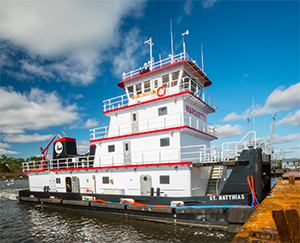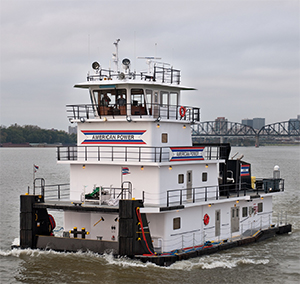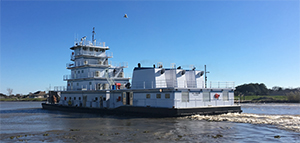SCF Marine of St. Louis has set a new standard for inland towboats with its class of 160-footers outfitted with three z-drive units. These 6,600-hp vessels are the largest and most powerful z-drive towboats working on the Mississippi River.
SCF Vision, the first of three planned vessels, was delivered earlier this year by C&C Marine and Repair of Belle Chasse, La., using a design developed by The Shearer Group of Houston. It primarily works in the Lower Mississippi River between New Orleans and St. Louis, according to Myron McDonough, SCF’s vice president.
Two additional vessels, SCF Mariner and SCF Explorer, are expected for delivery within the next year. All three are 160 by 50 by 11.5 feet with a draft of about 9.5 feet.
Vision’s propulsion system consists of three Cummins QSK60 Tier 3 mains driving three Steerprop drives. Ship service power comes from two John Deere 250-kW generator sets. There are six Wintech 65-ton winches installed at the bow and midbody.
“We looked at six manufacturers of propulsion units. After reviewing each unit’s drawings and/or features, we chose Steerprop. At that point we added several design changes to meet our needs,” McDonough said.
The Shearer Group used advanced computational fluid dynamics, or CFD, to maximize hull efficiencies and water reaching the z-drives. The firm also incorporated the barge train into the modeling to determine how the tow would affect performance.
“We found with the proper hull shape, the z-drive can increase the efficiency of the entire barge train,” said Joshua Sebastian, engineering manager with The Shearer Group.
These vessels also have a wastewater management system supplied by Controlled Water System that recycles graywater. Vision and its sister vessels can essentially operate as zero-discharge vessels.
SCF Marine, a Seacor subsidiary, chose the triple-screw propulsion system to meet draft restrictions on the river, McDonough said. But the added power and maneuverability also lets Vision move cargo safely and efficiently.
Karl Senner LLC of Kenner, La., supplied the drives and other propulsion components. In a statement, the company said it was “proud to equip M/V Vision with three Steerprop SP25D azimuth thrusters with stainless steel propellers, high-efficiency HJ3 nozzles, Centa shaft lines, control system and Voith Safeset torque-limiting couplings.”
Vision has an 11-person crew and eight cabins spread across three decks. There are also six full heads and one day head. Crew amenities include satellite TV and Internet, a workout room and a comfortable galley/mess area.
Ryan Point
Tidewater Transportation and Terminals of Vancouver, Wash., took delivery in June 2016 of Ryan Point, the third of three 102-by-38-foot towboats for barge handling on the Columbia-Snake River System in the Pacific Northwest.
Propulsion equipment consists of two Caterpillar 3516C Tier 3 engines each generating 2,240 hp at 1,600 rpm turning 92-by-100-inch stainless-steel props in Kort nozzles through Reintjes reduction gears. Running speed is 8 knots for the vessel, which has four steering rudders and four flanking rudders.
That equipment comes in handy when operating in the Columbia River Gorge and other sections of river where currents can reach 5 knots and winds can exceed 50 mph.
The full tow load for these vessels is four 274-by-42-foot grain barges for a total tow length of 650 feet. Those capacities are limited by the size of locks on the waterway.
Electrical power comes from two Caterpillar C7.1 gensets each rated for 200 kW. On the bow are seven Patterson 65-ton deck winches spooled with Samson 1-3/8-inch Turbo-75 synthetic line.
“We are really happy with boats, they have done everything we want them to do,” said Marc Schwartz, manager of maintenance and engineering for Tidewater. “The performance is great, the build was solid and … we are just really happy with the whole fleet of them.”
Crown Point and Granite Point, delivered in 2015 and 2016 respectively, preceded this vessel. All three were built at Vigor’s Portland shipyard with plans from CT Marine of Portland, Maine. This series of towboats is the newest in Tidewater’s 16-boat fleet.
 |
|
Marquette Transportation’s St. Matthias. |
|
Brian Gauvin |
St. Matthias/Chad Pregracke
Bayou La Batre, Ala., shipbuilder Master Marine completed an 11-boat order of 2,000-hp ASD towboats for Marquette Transportation with the December delivery of St. Matthias, the final boat in the class. Entech Designs of Kenner, La., provided the vessel plans.
These 78-by-34-by-11-foot vessels assigned to Marquette’s New Orleans-based Gulf-Inland division feature twin Caterpillar C32 engines each generating 1,000 hp at 1,800 rpm. The mains are connected to ZF Marine AT 5111 WM-FP z-drives turning 65-inch, four-bladed stainless steel props in nozzles.
Electrical power comes from John Deere 4045 engines driving Marathon 80-kW generators, and two Patterson 40-ton deck winches are installed on the bow to secure the tows. Master Marine completed the first boats in the class in 2014 and finished the order in December with delivery of St. Matthias.
Marquette also took delivery in October 2016 of the twin-screw Chad Pregracke, the third of three 180-by-48-by-11.5-foot vessels with 9,300 hp. Propulsion comes from twin EMD 20-710 G7C Tier 3 engines linked with Reintjes WAF 6755 gearboxes at a 4.762:1 reduction ratio turning 120-inch props in nozzles.
Gulf Island Marine Fabricators in Houma, La., built Chad Pregracke and its sister boats Rick Calhoun and Loree Eckstein using a design from CT Marine of Portland, Maine.
American Power/American Strong
American Commercial Barge Line (ACBL) has overseen a steady fleet modernization program over the past 15 months, adding 10 new towboats to its already sizable fleet. These newbuilds include American Power and American Strong, delivered in November and December 2016, respectively, by the company’s Jeffboat shipyard in Jeffersonville, Ind.
The 79-by-34-foot vessels have an 8.5-foot operating draft. Propulsion comes from twin Caterpillar C32 engines turning ZF Marine ZF 5000 z-drives with 63-inch props in nozzles. Electrical power comes from John Deere 4045 gensets each producing 65 kW. Boats in this class were designed to carry two 30,000-barrel liquid barges or 12 standard barges.
A pair of Patterson 40-ton electric deck winches are on the bow with a Wintech capstan. Six bunkrooms and a comfortable galley/mess can accommodate six to eight crewmembers for longer river voyages. Fuel capacity is 30,000 gallons.
In 2016, ACBL also took delivery of six 2,000-hp z-drive towboats built at Steiner Construction of Bayou La Batre, Ala., the most recent of which were American Valor and American Skill, both delivered in fall 2016. ACBL, headquartered in Jeffersonville, Ind., has more than 175 towboats working on U.S. inland waterways.
A.B. York/Cullen Pasentine/Victoria Pasentine
Florida Marine Transportation continued its feverish pace of new construction over the past year, taking delivery of five new vessels.
Largest of the Mandeville, La., company’s newbuilds were A.B. York, a 120-foot conventional towboat, and Marty Cullinan and Victoria Pasentine, 120-footers with jacking pilothouses. Horizon Shipbuilding of Bayou La Batre, Ala., built these 4,000-hp vessels using plans from Gilbert Associates of Braintree, Mass.
“This design has been enormously successful for Florida Marine Transporters, having built nine vessels so far in the last 10 years, seven conventional and two with jacking pilothouses,” naval architect John Gilbert said. “The boat’s success is probably due in part to the efficiencies garnered from the propeller tunnel design, and attention to steering and flanking rudder design.”
The tugs are equipped with twin Caterpillar 3512 Tier 3 engines linked with Twin Disc MG-5600 reduction gears turning 100-inch Sound propellers. Electricity comes from two John Deere 6090 gensets.
Eastern Shipbuilding of Panama City, Fla., also delivered the 90-by-32-foot Capt. Ricky Torres and Cullen Pasentine, bringing Florida Marine’s total order of 90-foot towboats to 65 over the last decade. The vessels have twin Caterpillar engines generating 3,000 total hp, Twin Disc MG-5600 gears and John Deere gensets.
The 90-foot class, believed to be the largest single-owner, single-builder vessel program in U.S. history, will soon grow even bigger. Florida Marine has ordered a 66th 90-footer expected for delivery later this year. Florida Marine also is building five 120-foot conventional towboats at its Harvey, La., shipyard.
Margaret Anne/Mackenzie Hope
Genesis Marine of Houston took delivery of five 2,680-hp towboats from John Bludworth Shipyard in 2016. In February, the Corpus Christi, Texas, shipyard delivered Margaret Anne, the latest in the class of 84-by-32-by-11-foot towboats.
Margaret Anne and its siblings are powered by twin Caterpillar 3512 diesel engines generating 1,340 hp each linked with Twin Disc reduction gears at a 6.04:1 ratio and 82-inch props. These towboats have two steering rudders and four flanking rudders. Ship service power comes from twin John Deere 99-kW gensets, and the vessels can carry 37,000 gallons of fuel.
Since April 2016, Bludworth has delivered Caroline Frances, Eleanor Hadley, Kaylin Nicole and Mackenzie Hope in addition to Margaret Anne. Bludworth also delivered Christopher Scott in 2016. While similar in design, the vessel is 8 feet longer and has a retractable pilothouse along with an ABS Great Lakes load line certificate.
 |
|
The American Commercial Barge Line vessel American Power. |
|
ACBL |
Genesis’ current newbuild program has lowered the average hull age of its inland fleet to less than 7 years for barges and less than 9 years for boats. The vessels Garland Gaspard, Kylie Brown and another as-yet unnamed towboat will also be delivered this year.
David J. Bangert
Gateway Dredging and Contracting of Old Monroe, Mo., took delivery in September 2016 of David J. Bangert, a 1,320-hp pushboat built by Barbour JB Shipyard in St. Louis. The Shearer Group of Houston provided the plans.
The 55-foot vessel is powered by two Cummins QSK19 engines that each produce 660 hp. The mains turn 64-inch props through Twin Disc gears at a 6:1 ratio.
Gateway Dredging operates four suction sand dredges on the Missouri and Mississippi rivers around St. Louis and has six towboats between 800 and 1,500 hp to support its dredging fleet. David J. Bangert, its latest vessel, replaces an aging fleet boat.
Cole Guidry
Bollinger Shipyard in Amelia, La., delivered the triple-screw towboat Cole Guidry to Lorris G. Towing of nearby Cut Off, La., in December 2016. Bollinger provided the vessel plans.
Cole Guidry gets its propulsion from three Tier 3 Caterpillar C18 engines supplied by Louisiana Machinery, which are each rated for 670 hp and linked with Twin Disc MGX-5170DC reduction gears at a 6:1 ratio. Three Kohler generators, each producing 65 kW, provide electrical power for the 80-by-36-foot vessel, which has a 10-foot draft.
“This vessel exceeds our expectations. Bollinger’s technology and craftsmanship are evident in the design and construction of this vessel. We can expand on this design to meet our future needs and the needs of our customers,” Luke Guidry Sr., president of Lorris G. Towing, said in a prepared statement.
The towboat can hold 20,000 gallons of fuel and 7,400 gallons of potable water. Four cabins — three double and one single — can accommodate seven crewmembers. Cole Guidry is the 11th vessel in the Lorris G. Towing fleet and is currently working along the Gulf of Mexico pushing fuel barges.
San Roberto/C.J. Studdert/Nancy Marian/Lt. Dick Dowling
Buffalo Marine Service of Houston took delivery of four towboats from Southwest Shipyard LP within the last year, including two with retractable pilothouses. Advance Fabricating Inc. provided the designs.
The San Roberto and C.J. Studdert, which measure 87 by 32 feet, are powered by twin Cummins QSK38-M1 engines producing 1,000 hp each with Twin Disc MG-540 reduction gears at a 6:1 ratio turning 78-inch four-bladed Sound propellers, according to specs provided by shipyard project manager Johnny Rodriguez. Electrical power comes from two Cummins QSB 7D gensets.
The two retractables, Nancy Marian and Lt. Dick Dowling, are 65 by 30 feet. Propulsion comes from twin Mitsubishi S6R-Y3MPTAW engines producing 630 hp. The reduction gears are Twin Disc, Sound Propellers supplied the wheels, and two John Deere 65-kW generators provide electrical power. The pilothouse lift system was supplied by Rio Controls & Hydraulics.
All four vessels were outfitted with Eastpark Radiator coolers, Schuyler Cos. fenders and Carrier HVAC systems.
Jackson Scott
Devall Towing & Boat Service of Sulphur, La., took delivery of the 64-by-27-foot Jackson Scott from Southwest Shipyard LP in April 2017. The pushboat was built based on plans from Advance Fabricating Inc.
Propulsion on the vessel comes from twin Mitsubishi S6R-Y3MPTAW engines generating 630 hp each at 1,600 rpm turning 70-inch, four-blade, stainless steel Dominator props through Twin Disc MGX-5222 gears at a 6:1 ratio, according to a spec sheet provided by the Houston shipyard. Electrical power comes from twin John Deere 65-kW generators.
Eastpark Radiator provided the coolers and Schuyler Cos. provided fendering and hull protection. Three Carrier units provide onboard heating and cooling. Jackson Scott can hold 6,000 gallons of potable water and 12,500 gallons of fuel.
Master Marine building four fleet boats
Master Marine of Bayou La Batre, Ala., is building four 67-by-28-foot fleet boats for Waterfront Services and CGB Enterprises. The vessels, with a 7.75-foot draft, will work in Cairo, Ill., and the lower Mississippi River fleeting areas with capabilities of fleeting and extended trip services.
These vessels will be powered by two Laborde Products Mitsubishi S6R2-Y3MPTAW Tier 3 engines generating a total 1,606 hp coupled with Twin Disc MGX-5321DC 4:98:1 gears. The pushboats will be set up for 10,400 gallons of fuel and 4,359 gallons of potable water.
The first delivery is set for summer 2017, and subsequent boats should be completed by mid-2018. The vessels will be built to comply with all Coast Guard Subchapter M requirements.

